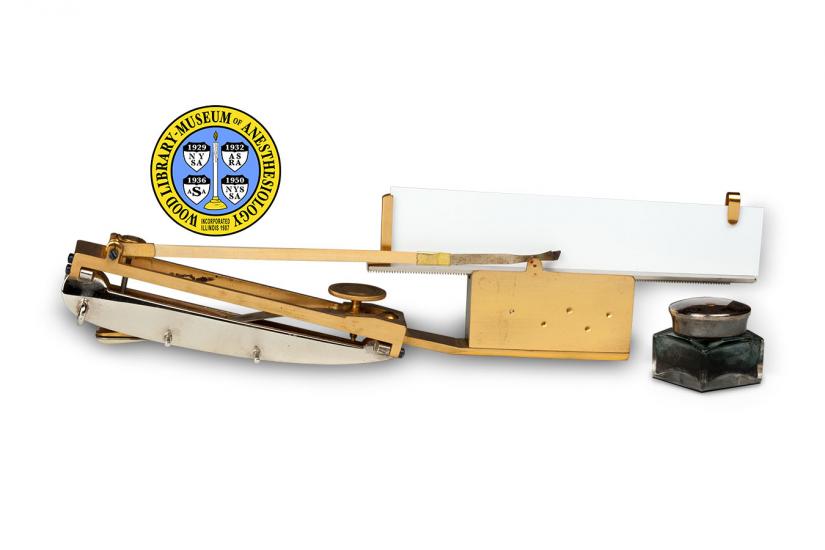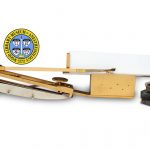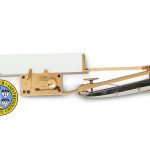Marey Sphygmograph
The first machine that could produce a paper record of blood pressure was introduced in 1847. Many other "sphygmographs" soon followed. In 1860, the French inventor, Dr. Étienne Jules Marey (1830-1904) described his own sphygmograph. Dr. Marey was a pioneer of blood pressure measurement and other physiological studies. He also pioneered cinematography as an aid to some of these studies.
His sphygmograph was held on the patient's forearm with a cloth band. An ivory plate was positioned on the patient's radial artery (the artery that parallels the radius bone in the arm). As the patient's pulse moved the plate, that motion was transmitted to a stylus which was dipped in ink. The moving stylus traced an ink line representing that motion on a piece of paper, while the paper was pulled forward by a clockwork mechanism. The Marey Sphygmograph became the first instrument of its kind to be widely used in clinical medicine.
Catalog Record: Marey Sphygmograph
Access Key: akoc
Accession No.: 2001-04-25-2
Title: Sphygmographe de Marey / Ch. Verdin, G. Boulitte.
Author: Marey, Etienne Jules, 1830-1904.
Title variation: Alt Title
Title: Marey Sphygmograph.
Publisher: Paris : Ch. Verdin, G. Boulitte, [1900-1935].
Physical Descript: 1 sphygmograph : metals, textiles, ink, paper : 5.5 x 22.5 x 10.5 cm.
Subject: Pulse – history.
Subject: Pulse – instrumentation.
Subject: Cardiovascular Physiology.
Subject: Blood Pressure – physiology.
Note Type: General
Notes: Date range for the possible year of manufacture is an estimate based on the
year when Verdin retired (1901) and on the latest year that a catalog with
the names of both Verdin and Boulitte are printed was found (1930). The date
range could change if documentation indicates the range should be corrected.
Note Type: Citation
Notes: Braun M. Picturing Time: The Work of Etienne-Jules Marey (1830-1904).
Chicago: University of Chicago Press; 1992
Note Type: Citation
Notes: Brown JG. Circulatory system: graphic clinical methods. Medical Diagnosis: A
Manual of Clinical Methods. Edinburgh: Bell & Bradfute; 1882:110-112.
Note Type: Citation
Notes: Lawrence C. Physiological apparatus in The Wellcome Museum: 1. The Marey
sphygmograph. Med Hist. 1978;22(2):196-200.
Note Type: Citation
Notes: Marey EJ. Recherches sur le pouls au moyen d’un nouvel appareil enregistreur:
le sphygmographie. Paris:E. Thunotet Co.; 1860. https://www2.biusante.
parisdescartes.fr/livanc/?cote=153599×10&do=chapitre. Accessed November 14,
2013.
Note Type: Citation
Notes: Marey, Étienne-Jules. Complete Dictionary of Scientific Biography. Detroit:
Scribners, 2008;101-103.
Note Type: Citation
Notes: McIntyre N. Medical statues: Etienne Jules Marey (1830-1904). J Med Biogr.
2005;13(3):141.
Note Type: Citation
Notes: Obituary: Etienne Jules Marey. BMJ. May 28, 1904;1(2265:1289-1290.
Note Type: Physical Description
Notes: One box lined with a dark brown buckram on the outside and a maroon velvet on
the inside; There are five different compartments for holding the instruments
and accompanying items; Marked on the top of the box is, “SPHYGMOGRAPHE [new
line] DE MAREY”; The sphygmograph is made of brass and other metals; It
measures approximately 19.5 cm long, 4.5 cm in height and 3.2 cm in width; A
thin, flexible lever of steel (which acts as a spring) has a smooth ceramic
or ivory plate at its end; The ivory plate is intended to be placed over the
radial artery; On the end nearest the wrist are extensions for strapping the
instrument onto the arm; Mechanisms transfer the movement of the radial
artery to a stylus at the most proximal end of the sphygmogram, which could
trace the movements on a strip of paper that was moved by a clock mechanism;
Marked in the proximal end of the device is, “CH. VERDIN [new line] G.
BOULITTE [new line] 7 Rue LINNE, PARIS”; Also in the box is a black ink well,
paper strips, and two extra stylus.
Note Type: Reproduction
Notes: Photographed by Mr. Steve Donisch, June 10, 2013.
Note Type: Historical
Notes: This sphygmograph, or ‘pulse writer’, was designed by French physician
Etienne Jules Marey (1830-1904) and introduced in 1860. It created a graphic
image of a person’s pulse. Made mostly of brass, it was firmly tied to the
forearm and wrist. A small plate was positioned over the radial artery and
the movements of the the pulse were transmitted to a recording stylus. A
clockwork mechanism moved a strip of paper under the stylus so that an
undulating line of the pulse was traced. It created a graph of the pulse that
looked very much like the waves displayed on monitoring equipment used by
anesthesiologists today.
Marey was not the first to invent such a device but his was smaller and
easier to use than previous designs. It inspired a number of modifications
and was employed mostly for research into cardiovascular physiology and
diseases.
Marey is best known in medicine for his inventions and work in the study of
physiology. His interest in visually capturing small and large movements has
led some know him for his early work studying the mechanics of flight, and
many others to know him as the ‘Father of Cinematography.’
Note Type: Publication
Notes: Dudgeon RE. The Sphygmograph: Its History and Use as an Aid to Diagnosis in
Ordinary Practice. London: Bailliere, Tindall, and Cox; 1882.
https://ia600707.us.archive.
org/31/items/sphygmographitsh00dudg/sphygmographitsh00dudg.pdf. Accessed
November 4, 2013.
Note Type: Exhibition
Notes: Chosen for the WLM website (noted November 4, 2013).



